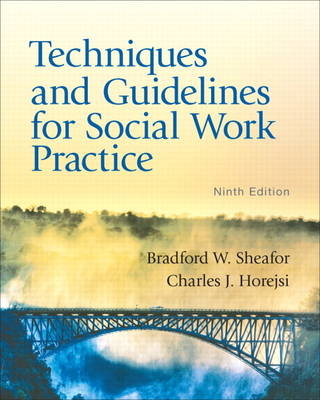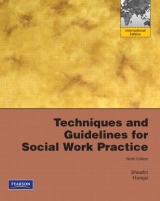
Techniques and Guidelines for Social Work Practice
Pearson (Verlag)
978-0-205-83875-2 (ISBN)
- Titel erscheint in neuer Auflage
- Artikel merken
Parts I and II provide knowlege, values, and competencies for effective social work practice, while Parts III through V contain 144 clear and readable descriptions of practice techniques, presented in a handbook format for convenient accessibility of information.
.
Brad Sheafor is Professor of Social Work at Colorado State University where has taught a wide variety of courses in both the BSW and MSW programs. He has also served in administrative positions including Director of the social work program, Associate Dean for Research and Interim Dean of the umbrella college that includes social work, Associate Director of the Human Factors Research Laboratory, and Co-Director of the Family and Youth Institute. Dr. Sheafor has served as a juvenile probation officer, director of a community planning council, and as president of his local United Way. He has been a member of the Exam Committee for the Association of Social Work Boards (licensing), part of the workgroup creating NASW’s Center for Workforce Studies, and a founding member of the Baccalaureate Program Directors Association. With the Council on Social Work Education he has been President, Senior Scholar, and recipient of CSWE’s Lifetime Achievement in Social Work Education Award. He has also been a Fulbright Lecturer to New Zealand and a Visiting Fellow in Australia. Dr. Sheafor is co-author of 23 books listed with the Library of Congress. In addition to Techniques for Social Work Practice (8 editions with Charles Horejsi), he has co-authored 12 editions of Social Work: A Profession of Many Faces (with Armando Morales and Malcolm Scott), a history of the development of baccalaureate social work in the United States (with Barbara Shank), a book on field instruction (edited with Lowell Jenkins), and book reporting a comprehensive task analysis of social work practice (with Robert Teare). Charles Horejsi is currently Professor Emeritus at the University of Montana having served that university for a number of years as a faculty member teaching primarily child welfare and social work practice courses, as well as being involved with the School of Social Work’s field instruction program. A licensed clinical social worker, Dr. Horejsi had practice experience in marriage and family counseling, child welfare, and juvenile probation. He conducted agency staff training in more than a dozen states and received the Montana NASW’s “Social Worker of the Year” award recognizing his many contributions to strengthening the quality of social work in that state. Dr. Horejsi’s research has focused on risk assessment in child protection, issues of worker safety on the job, and on methods of assessment and case planning in child welfare agencies. In addition to numerous monographs and more than 30 professional articles, Dr. Horejsi has authored or co-authored 13 books listed with the Library of Congress. These publications include: Family Foster Care: A Handbook for Social Workers, Social Work Practice with Parents of Children in Foster Care: A Handbook (with Anne Vandeberg Bertsche and Frank Clark), three editions of The Social Work Practicum: A Guide and Workbook for Students (with Cynthia Garthwait), and eight editions of Techniques and Guidelines for Social Work Practice (with Bradford Sheafor).
Preface
I. SOCIAL WORK AND THE SOCIAL WORKER
1. The Domain of the Social Work Profession
The Social Work Domain
An Overview of Social Work Practice
2. Merging Person with Profession
Selecting Social Work as a Career
Establishing Oneself as a Social Worker
The Interplay of One's Personal and Professional Lives
A Fitness Program for the Social Worker
Having Fun in Social Work
3. Merging the Person's Art with the Profession's Science
The Social Worker as Artist
The Social Worker as Scientist
II. THE BUILDING BLOCKS OF SOCIAL WORK PRACTICE
4. The Roles and Functions Performed by Social Workers
Identifying Professional Roles
5. Guiding Principles for Social Workers
Principles that Focus on the Social Worker
Principles that Guide Practice Activities
6. Practice Frameworks for Social Work
Requirements of a Practice Framework
Guidelines for Selecting a Practice Framework
Selected Practice Perspectives
Selected Practice Theories and Models
7. Using Evidence to Guide the Change Process
Evidence-Based Practice
Critical Thinking When Making Practice Decisions
Guiding the Planned Change Process
The Context of Planned Change
Identifying the Actors in Planned change
Phases of the Planned Change Process
III. TECHNIQUES COMMON TO ALL SOCIAL WORK PRACTICE
8. Basic Communication and Helping Skills
Creating an Effective Helping Relationship
Verbal Communication Skills
Nonverbal Communication Skills
Helping Skills
Enhancing Client Motivation
Understanding Emotions and Feelings
Responding to Defensive Communication
Elements of Professional Behavior
Making Ethical Decisions
Applying Cultural Competence to Helping
9. Basic Skills for Agency Practice
Written Reports and Correspondence
Effective Telephone Communications
Using Information Technology
Client Records and Documentation
Managing Time and Workload
IV. TECHNIQUES AND GUIDELINES FOR PHASES OF THE PLANNED CHANGE PROCESS
10. Intake and Engagement
Introduction
Section A. Techniques and Guidelines for Direct Practice
Section B. Techniques and Guidelines for Indirect Practice
11. Data Collection and Assessment
Section A. Techniques and Guidelines for Direct Practice
Section B. Techniques and Guidelines for Indirect Practice
12. Planning and Contracting.
Section A. Techniques and Guidelines for Direct Practice.
Section B. Techniques and Guidelines for Indirect Practice.
13. Intervention and Monitoring
Section A. Techniques and Guidelines for Direct Practice
Section B. Techniques and Guidelines for Indirect Practice
14. Evaluation and Termination
Section A. Techniques and Guidelines for Direct Practice
Section B. Techniques and Guidelines for Indirect Practice
V. SPECIALIZED TECHNIQUES AND GUIDELINES FOR SOCIAL WORK PRACTICE
15. Guidelines for Working With Vulnerable Client Groups
The Client Who Is Experiencing Poverty
The Client Who Is a Child
The Client Who Is an Adolescent
The Client Who is a Parent or Grandparent
The Client Who Is an Older Person
The Client Who Is A Battered Woman
The Client Who Is at Risk of Suicide
The Client with an Intellectual Disability
The Client with Brain Injury
The Client with a Serious Physical Disability
The Client Who Is Chemically Dependent
The Client with a Serious Mental Illness
The Client on Psychotropic Medication
The Client Who is Gay, Lesbian, Bisexual, or Transgender
The Client with an Eating Disorder
The Client Experiencing Grief or Loss
The client with Concerns Related to Spirituality and Religion
The Client Who is Affected by War
The Client Who is an Immigrant or Refugee
The Client or Community Experiencing an Emergency or Disaster
16. Techniques for Sustaining Social Work Practice
Getting a Social Work Job
Preparing for Social Work Competency Exams
Developing Self-Awareness
Avoiding Compassion Fatigue and Stress Management
Dealing with Sexual Misconduct
Avoiding Malpractice Suits
Testifying in Court
Giving and Receiving Supervision
Building and Maintaining Mentoring Relationships
Consuming and Contributing to Professional Knowledge
Improving the Social Work Image
Becoming a Leader
Appendix A: Acronyms Commonly Used in Social Work
Appendix B: Retired Techniques and Guidelines from Prior Editions
Author Index
Subject Index
| Erscheint lt. Verlag | 8.3.2011 |
|---|---|
| Sprache | englisch |
| Maße | 203 x 254 mm |
| Gewicht | 800 g |
| Themenwelt | Schulbuch / Wörterbuch |
| Sozialwissenschaften ► Pädagogik ► Sozialpädagogik | |
| Sozialwissenschaften ► Soziologie | |
| ISBN-10 | 0-205-83875-8 / 0205838758 |
| ISBN-13 | 978-0-205-83875-2 / 9780205838752 |
| Zustand | Neuware |
| Haben Sie eine Frage zum Produkt? |
aus dem Bereich



